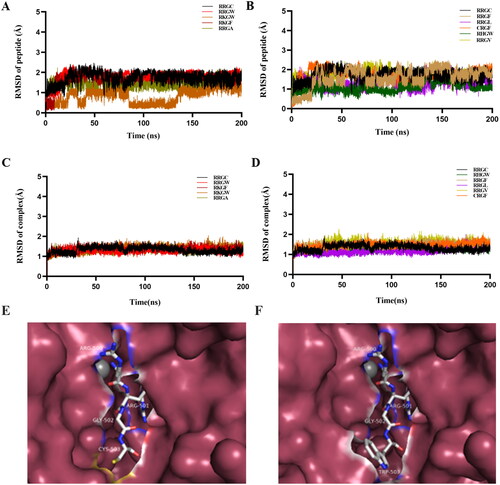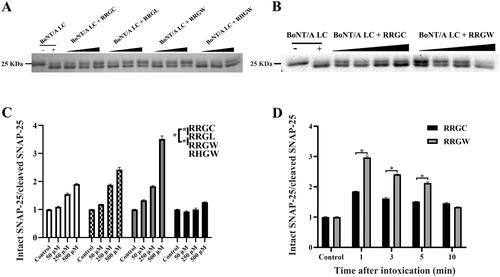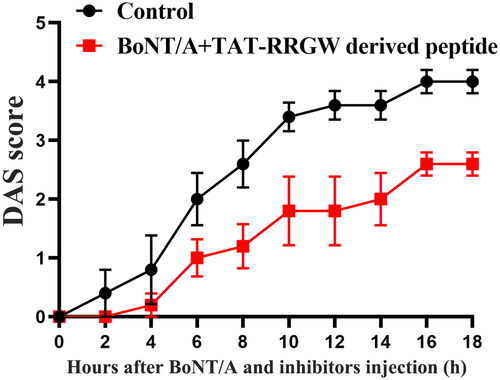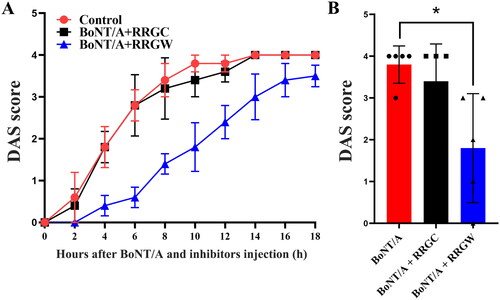Figures & data
Table 1. The pool of polypeptide inhibitors generated.
Table 2. Docking scores of polypeptide inhibitors with BoNT/A LC.
Figure 1. RMSD of the complex and polypeptide inhibitors. (A, B) The RMSD of the protein skeleton atoms of the polypeptide inhibitors; (C, D) The RMSD of the skeleton atoms of complex. (E) The receptor-ligand interaction of RRGC with the BoNT/A LC active site; (F) The receptor-ligand interaction of RRGW with the BoNT/A LC active site.

Table 3. The free energy of peptide inhibitors binding with BoNT/A LC and the energy contribution of different components.
Figure 2. RRGW peptide showed higher inhibitory effect on BoNT/A LC proteolytic activities in vitro. SDS-PAGE results of intact and cleaved SNAP-25 in master mix after reaction with BoNT/A LC in the presence of inhibitors. The control refers to the group without inhibitor. (A) The protection effect of inhibitors after co-treated with BoNT/A at different concentrations; (B) The rescue effect of inhibitors in 1, 3, 5 and 10 min after exposure to BoNT/A LC; (C, D) Semi-quantification of intact SNAP-25 and cleaved SNAP-25 in A and B, respectively. The concentrations of inhibitors were 50 μM, 250 μM and 500 μM in A and C; and 500 μM RRGC and RRGW were used in B and D. The data are the average of three replicates, and * indicated there is significant difference between the treatment group and the control at p < 0.05.

Figure 3. RRGW derived peptide showed higher inhibitory effect on BoNT/A LC proteolytic activities in vitro. (A) C-terminal sequence of different derived peptide; (B) The protection effect of inhibitors after co-treated with BoNT/A at different concentrations; (C) The rescue effect of RRGW derived peptide in 1, 2, 3, 5 and 10 min after exposure to BoNT/A LC; Double-reciprocal plots of velocity versus substrate concentration at several fixed concentration of RRGW (D) and RRGW derived peptide (E). The data are the average of three replicates, and * indicated there is significant difference between the treatment group and the control at p < 0.05.

Figure 4. Co-injection of RRGW derived peptide with BoNT/A delayed BoNT/A-induced leg muscle paralysis. DAS score of the leg muscle paralysis progression within 18 h after injection with 0.75 U BoNT/A or co-injection with 0.75 U BoNT/A and 10 μL inhibitors. 25 μM RRGW derived peptide was used. There were five mice in each group, and * indicated there was significant difference between the treatment group and the control at p < 0.05.

Figure 5. Co-injection of short peptides with BoNT/A delayed BoNT/A-induced leg muscle paralysis. (A) DAS score of the leg muscle paralysis progression within 18 h after injection with 0.75 U BoNT/A or co-injection with 0.75 U BoNT/A and 10 μL inhibitors; (B) DAS score of the leg muscle paralysis at 10 h after injection with BoNT/A or co-injection with BoNT/A and inhibitors. 500 μM RRGW and RRGC were used. There were five mice in each group, and * indicated there was significant difference between the treatment group and the control at p < 0.05.


